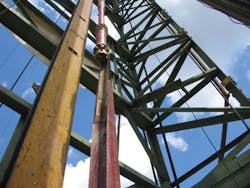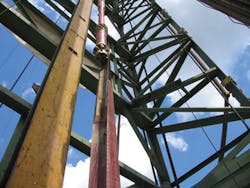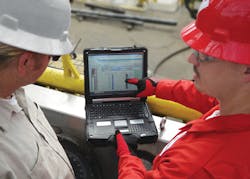Intervention solution proves effective in deepwater fields
Data-tracking/transmission package boosts efficiency
Adrian Vuyk, Jr.
Weatherford International
From straightforward cleanouts and casing exits to complex workovers, well intervention is a continuous and necessary aspect of hydrocarbon production that boosts exploration potential, extends the life of producing wells, and rejuvenates old ones.
In the high-profiledeepwater sector, however, even the most routine well interventions are subjected to the highest degree of scrutiny, as operators consider the risks inherent in an arena where the cost of failure is considerable. For this environment, sophisticated and integrated systems that deliver reliability and certainty in ways that foster collaboration are essential to maximizing efficiency, economics, and safety.
Underlying that objective is the need to combine the best casing-exit technologies with real-time data that is both comprehensive and actionable. An enhanced casing-exit service, for example, comprises a powerful data-gathering package, a field-proven milling tool, and 24/7 technical expertise to meet the demands of the most challenging environments. These environments can include deepwater, extended-reach, multilateral and mature well profiles; wells with high dogleg severity; and infill drilling.
With this expanded capability, the Weatherford QuickCut Pro service can deliver measurable gains in reliability and repeatable precision in milling casing-exit windows, ultimately reducing downtime and minimizing trips downhole.
A key aspect of the casing-exit service is the collaborative AccuView data-tracking and transmission software and hardware system. This patented system serves as a real-time portal for both the onsite crew and an onshore team of experts to consistently and precisely plan and execute a precise casing exit, in a minimum number of trips. Precisely milled casing-exit windows provide access to additional reservoirs and further serve as a contingency for bypassing obstructed or damaged wellbores.
The new service increases the likelihood that casing-exit windows are milled with a geometry that provides optimum compatibility with drilling and liner programs, regardless of casing size, grade, depth, inclination, formation characteristics, or even the number of casing strings that have to be milled. It includes an intuitive user interface that enables real-time communication and decision-making during the operation by uniting the rig crew with a regional or global support team. The solution is proving especially effective in producing clean, precise, and smooth casing exits in high-tier deepwater fields where the need for accuracy is paramount.
Officially launching at the SPE Annual Technical Conference & Exhibition in Dubai in September, the data-tracking and transmission service has been incorporated in dozens of field trials, including a multi-pad exploration platform in the North Sea.
Classroom to field
The data-tracking and transmission system marks the culmination of an effort that began nearly five years ago as a classroom training mechanism. Students were using a simulator to virtually mill casing-exit windows on a computer. To make the training even more interactive, data from each student was shared with the classroom in real time. This approach resulted in a marked improvement in the students’ window-milling performance, validating that real-time access to real-time data from other wells can result in better-milled windows.
Recognizing that the software represented an opportunity to reduce risk and improve reliability when milling real-world casing-exit windows, Weatherford refined and adapted the software for commercial use in 2015. The software’s procedural design particularly lends itself to deepwater applications, where operators need to have well-documented procedures.
The plug-and-play technology includes a highly portable field kit containing software that securely captures and distributes data from the rig’s existing electronic drilling recorder. A magnetized antenna transmits data to decision makers on site while a network connection enables data transmission to the off-site experts.
Once the hardware is installed on the rig, the service provides and clearly displays actionable, operation-specific and real-time information, enabling rig crews to analyze current events and anticipate coming events without suspending rig operations. In this way, the operator and driller can forecast and plan for any contingency before it happens. At the same time, onshore experts can log into the system remotely to quickly access current real-time data as well as the operational history of the project to make informed recommendations to the rig crew.
The software enables authorized team members, who may be in different geographic locations, to view the same job and communicate via instant messaging at all times. While the operator maintains his focus on the job at hand, the software calculates “what-if” scenarios based on real-time well data to anticipate key casing-exit events and predict their impact on the operation. The software also leverages the Weatherford Performance Tracking System (WPTS), which includes a referential database of more than 5,500 casing-exit operations that can be used to provide further historical analysis and reduce uncertainty.
Real-time collaboration
In one of the first field deployments of the integrated casing-exit service, an offshore operator in The Netherlands needed to perform a 20-in., 94 lb/ft, X-56 casing exit on a multi-pad exploration platform in order to complete the well while the next pad was being prepared for drilling. Otherwise, the client would have had to abandon the slot and leave the rig idle for several months at a significant daily operating cost.
Weatherford deployed the enhanced casing-exit service, including the casing-exit system and data-tracking and transmission software, along with an onsite team and an onshore team of experts who engaged in a collaborative and extensive pre-job planning process. During the planning phase, the teams identified key performance indicators, including rate of penetration (ROP), pressure and flow rate. Parameters were then established and made available on the rig floor in an easy-to-interpret graphical user interface to check the actual milling data against the plan, foot by foot.
The software’s ability to save and recall target performance parameters enables jobs to be planned once and then adjusted or repeated for continuous process improvement. It creates an asset-manager-controlled template that includes pre-loaded documents, such as job hazard analysis, lift plans, technical manuals and checklists. The template files can be downloaded and used to create job-specific documents that can be shared with stakeholders to reduce job-to-job variation and result in continuous improvement.
Problem solving
On occasion, downhole tools fail to perform as planned. When this happens, the value of real-time collaboration increases, as demonstrated through two case histories. In one case, the operator encountered difficulties related to setting the whipstock anchor based on the flow rate. Because the connections and bottomhole assembly (BHA) were configured on land by a separate crew, there was some uncertainty regarding the size and configuration of the downhole tools. Notably, the operator was not certain of the nozzle size. This knowledge gap could have necessitated a costly and time-consuming trip out of the hole to replace the BHA so that the operator could proceed with greater certainty.
However, in this case, the onshore team was able to work in parallel with rig operations to run all potential hydraulic scenarios with the various nozzle sizes and calculate a recommended solution. Based on the computer simulations, the two teams jointly determined that the nozzle size did not represent a substantial risk. The fact that this decision was made in real time based on exact parameters by a team of onshore and offsite experts saved time and also produced documentation that could be used to validate the solution during post-job analysis.
The communication enabled by the casing-exit service eliminated the doubt introduced by the unknown nozzle size, and enabled the crew to determine an on-the-job hydraulic solution that guaranteed successful anchor-setting. Further, the gap identified during planning was used to quickly eliminate the same gap from recurring on all future jobs.
The second case study relates to a perhaps more-common challenge: core point. During the window-milling sequence, when the center line of the lead mill crosses over the middle of the casing wall, the mills will naturally slow down as reactive torque is reduced. This is called core point. The rate of decline is usually short lived.
On this occasion, the ROP declined to a rate that suggested to some personnel on the rig that the milling cutting structure needed to be replaced, which would have required a second trip to install a backup set of mills. Before embarking on that course of action, the supervisor consulted the onshore team, who tapped into the referential database to research the performance history of the BHA on other wells at similar conditions and total milling feet. Plotting data points of past performance enabled the combined team to directly compare the ROP decline and recovery seen on previous jobs to the current operation. This exercise extended the knowledge base beyond an individual crew’s experience to include the collective experience of all prior crews.
The analysis revealed that the ROP was likely to naturally increase substantially after about 30 minutes, and that with minor parameter adjustments, the current BHA would have a high probability of completing the window in a single trip. Armed with performance data, the offshore team was able to convince the rig personnel to be patient, adjust parameters and wait 45 to 60 minutes for the ROP to naturally recover and provide an extremely smooth window trajectory. The target milling parameters were adjusted and monitored remotely from shore. Throughout this process, the milling operation continued with no interruptions and behaved exactly as predicted.
Ongoing value
The casing-exit service, empowered by the data tracking and transmission software, has been deployed in numerous wells and applications around the globe, each time producing savings for operators by minimizing trips and rig time.
As oil and gas production companies venture into increasingly challenging frontiers where the cost of failure is high and the appetite for risk low, services that combine the best casing-exit tools with usable real-time data available 24/7, are critical for maximizing intervention efficiency through reduced costs and time while enhancing safety.


